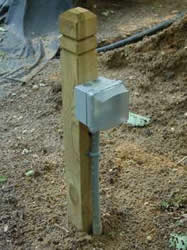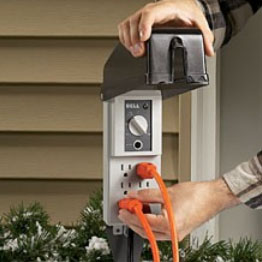Many landscape and gardening projects require a 120 VAC circuit to power lighting, other electrical devices such as pumps for ponds, as shown in Figure 2 and garden tools.

Figure 2 - Electrical receptacle installed in landscape
The actual placement of a receptacle within your landscape or gardening project needs to be thought out carefully as they are difficult to relocate if you place it wrong the first time.
Installing an electrical receptacle outdoors means purchasing the materials that were designed for the application.

Figure 1 - Outdoor electrical receptacle with timer
Weatherproof utility boxes and outdoor receptacle covers are a necessity if you do not want the circuit to trip every time it rains.
If the electrical receptacle is required for an outdoor lighting package you may want to consider installing a timer as part of the electrical installation, see Figure 1.
Powering the circuit through a GFCI (ground fault circuit interrupter) is mandatory for safety purposes. It is best if you can install the circuit directly to the main load center (distribution panel) powered through a GFCI breaker. If that is impracticable because of access, then the circuit can be powered from a GFCI receptacle.
Note: Only one GFCI control device is required on any circuit. All receptacles and devices wired from the GFCI are protected by that one device. Multiple GFCI devices on the same circuit will cause false tripping.
Electrical receptacles should never be placed horizontally, facing up or down, as water will penetrate the device and cause a short circuit. The proper position is vertical. The bottom of the receptacle should be a minimum of 6 inches above the ground and that includes any mulch that you use as a ground dressing.
When determining the best placement for the electrical receptacle, keep in mind that you will be doing your day-to-day gardening around it. Keep it away from lawnmower paths!
It is also wise to consider where sprinkler heads are located and if possible situate the electrical receptacle face away from the direct impact of sprinkler's water spray.
Placing electrical receptacles in an area that may be inundated with shrubs is not a wise move as someday you will want to be able to plug and unplug electrical devices.
Although you can purchase electrical cable that is made for direct burial, I recommend the use of PVC conduit in all landscape and gardening electrical applications. Conduit is less likely to be damaged when digging and allows for convenient replacement of damaged wires and the addition of more electrical circuits at a later time.
Additional information on Landscape Wiring
Additional information on Landscape Lighting
